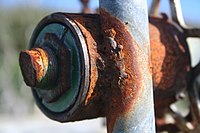
Photo from wikipedia
N2O is a hazardous greenhouse gas. It should be reduced to solve global warming problems. In this study, experiments of N2O thermal decomposition were conducted by simulating the exhaust gas… Click to show full abstract
N2O is a hazardous greenhouse gas. It should be reduced to solve global warming problems. In this study, experiments of N2O thermal decomposition were conducted by simulating the exhaust gas atmosphere emitted during the combustion of air and pure oxygen in an actual circulating fluidized bed system and incinerator system. As a result of comparing the N2O reduction rate in N2 and CO2 atmospheres, the N2O reduction rate in the CO2 atmosphere was 20% higher than that in the N2 atmosphere. It is judged that the N2O reduction rate is high in a CO2 atmosphere (exhaust gas from pure oxygen combustion) due to complex factors such as the reverse reaction, the diffusion coefficient, and static pressure-specific heat. Therefore, pure oxygen combustion increases the reduction rate of nitrous oxide. In addition, when operated with an appropriate residence time and temperature, a reduction effect of more than 95% can be expected, and the fuel consumption rate is also expected to improve.
Journal Title: ACS Omega
Year Published: 2022
Link to full text (if available)
Share on Social Media: Sign Up to like & get
recommendations!